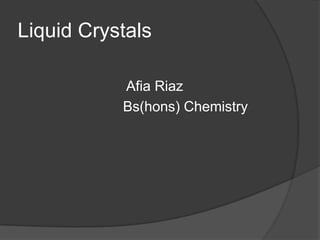
Liquid crystal
- 1. Liquid Crystals Afia Riaz Bs(hons) Chemistry
- 2. What are liquid crystals ? and liquid state offrom organic compounds and is thought of as the phase of matter Liquid crystals form a crystal.This phenomena was discovered in 1888 by between the solid and liquid state of a crystal.This phenomena was discovered in Austrian chemist Frederich Reinitzer Liquid 1888 by Austrian chemist Frederich Reinitzer crystals form from organic compounds and is thought o f as the phase of matter between the solid and liquid state of a crystal.This phenomena was discovered in 1888 by Austrian chemist Frederich Reinitzer. form from organic compounds and is thought of as the phase of matter between the solid and liquid state of a crystal.This phenomena was discovered in 1888 by Austrian chemist Frederich Reinitzer. chemist Frederich Reinitzer.
- 3. • A liquid crystal is substance that exhibit one or more ordered phases at a temperature above the melting point of solids. • Instead of passing directly from the solid to the loquid phase when heated these substance pass through an intermediate which has some of the freedom of motion possessed by liquids. • Due yo partial ordering liquid crystal may be very viscous and possess intermediate properties.
- 4. •
- 5. • There are many different types of LC phases, which can be distinguished by their different optical properties. • When viewed under a microscope using a polarized light source, different liquid crystal phases will appear to have distinct textures. • Despite significant differences in chemical composition, these molecules have some common features in chemical and physical properties.
- 6. • Substances that form liquid crystal structures are quite common. Approximately 0.5% of known carbon compounds have liquid crystal states. • Cholesterol myristate changes from the solid state to an intermediate state (cloudy liquid) at 71 C, and from the intermediate state to the liquid state at 86 C
- 10. Thermotropic liquid crystals Thermotropic phases are those that occur in a certain temperature range. If the temperature rise is too high, thermal motion will destroy the delicate cooperative ordering of the LC phase, pushing the material into a conventional liquid phase. At too low temperature, most LC materials will form a conventional crystal Many thermotropic LCs exhibit a variety of phases as temperature is changed.
- 11. 1. Nematic phase One of the most common LC phases is the nematic.In a nematic phase, the calamitic or rod-shaped organic molecules have no positional order, but they self-align to have long-range directional order with their long axes roughly parallel. Thus, the molecules are free to flow. Nematics have fluidity similar to that of ordinary (isotropic) liquids but they can be easily aligned by an external magnetic or electric field.
- 12. 2.Smectic phases • The smectic phases, which are found at lower temperatures than the nematicform • well-defined layers that can slide over one another in a manner similar to that of soap. The smectics are thus positionally ordered along one direction. • More order and higher viscosity
- 13. 3.Blue Phases • Liquid crystal 'blue phases' are highly fluid self-assembled three-dimensional cubic defect structures that exist over narrow temperature ranges in highly chiral liquid crystals • It was theoretically predicted in 1981 that these phases can possess icosahedral symmetry similar to quasi crystals.
- 14. • In May 2008, the first Blue Phase Mode LCD panel had been developed
- 15. Lyotropic liquid crystals • A lyotropic liquid crystal consists of two or more components that exhibit liquid- crystalline properties in certain concentration ranges. In the lyotropic phases, solvent molecules fill the space around the compounds to provide fluidity to the system
- 16. Amphiphilic molecule • A compound, which has two immiscible hydrophilic and hydrophobic parts within the same molecule, is called an amphiphilic molecule. Many amphiphilic molecules show lyotropic liquid-crystalline phase sequences depending on the volume balances between the hydrophilic part and hydrophobic part. • Soap is an everyday example of a lyotropic liquid crystal.
- 17. Biological liquid crystals • Lyotropic liquid-crystalline phases are abundant in living systems, • biological membranes and cell membranes are a form of liquid crystals • For instance, the concentrated protein solution that is extruded by a spider to generate silk is, in fact, a liquid crystal phase. • DNA and many polypeptides can also form LC phases
- 18. Uses of Liquid Crystals • Flat screen television • Wristwatches • Laptop screens • Digital clocks • Thermometers • Switchable windows
- 19. Conclusion • We know today that many chemical compounds can exist in the liquid crystal state, such as cholesteryl benzoate. the world can focus on ways to make this product useful in society. Over the last century many applications such as the detection of hot points in microcircuits, the findings of fractures or tumors in humans and the conversion of infared images have become accessible due to the understanding of pitch in a liquid crystal
